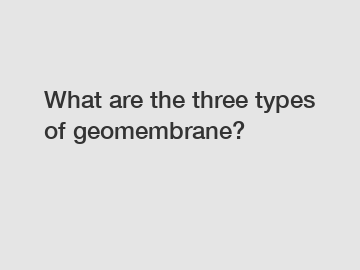What are the three types of geomembrane?
What are the three types of geomembrane? Geomembranes are impermeable liners used in various civil engineering, environmental, and geotechnical applications to control fluid migration. The three types of geomembranes commonly used are high-density polyethylene (HDPE), polyvinyl chloride (PVC), and ethylene propylene diene monomer (EPDM).
High-density polyethylene (HDPE) geomembranes are made from a high-density polyethylene resin, which is produced by the polymerization of ethylene under high pressure and temperature conditions. HDPE geomembranes have excellent chemical and physical properties, including high tensile strength, elongation, and puncture resistance. They are widely used in landfill liners, mining heap leach pads, and wastewater treatment plants due to their excellent resistance to chemicals, UV radiation, and harsh environmental conditions.
Polyvinyl chloride (PVC) geomembranes are made from polyvinyl chloride resin, plasticizers, and other additives. PVC geomembranes are known for their flexibility, weldability, and resistance to a wide range of chemicals. They are commonly used in applications such as decorative ponds, floating covers, and secondary containment systems. PVC geomembranes are available in different thicknesses and can be easily installed using hot air or radiofrequency welding techniques.

Ethylene propylene diene monomer (EPDM) geomembranes are manufactured from a synthetic rubber compound known as EPDM. EPDM geomembranes possess exceptional UV resistance, high strength, and elongation properties, making them suitable for applications where longevity and durability are essential, such as reservoirs, canals, and irrigation systems. They are also resistant to ozone, heat, and weathering, making them highly versatile in various environmental conditions.
The selection of the type of geomembrane depends on several factors, including the specific application, site conditions, and project requirements. For instance, HDPE geomembranes are preferred in projects requiring superior chemical resistance, while PVC geomembranes are often chosen for their cost-effectiveness in smaller applications. EPDM geomembranes are favored for their excellent weathering resistance and long-term performance. The availability of different types of geomembranes allows engineers and designers to choose the most suitable option based on the project's needs and constraints.
In conclusion, the three types of geomembranes commonly used are HDPE, PVC, and EPDM. Each type has its unique properties and advantages, making them suitable for various applications. Understanding the differences and benefits of these geomembranes is crucial for selecting the right material to ensure the success and longevity of engineering and environmental protection projects.
If you are looking for more details, kindly visit trp geocell, geosynthetics manufacturer and supplier, rpp geomembrane liner.

Comments